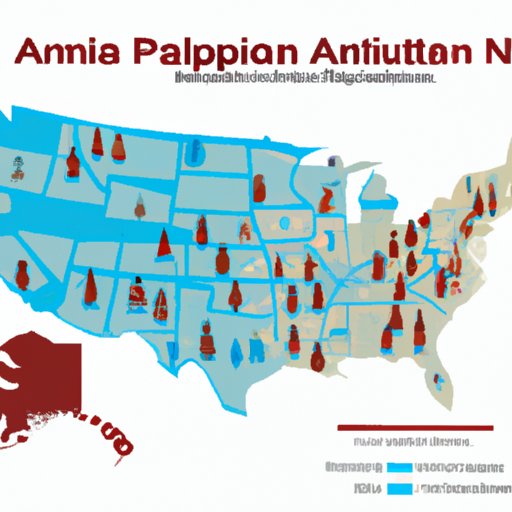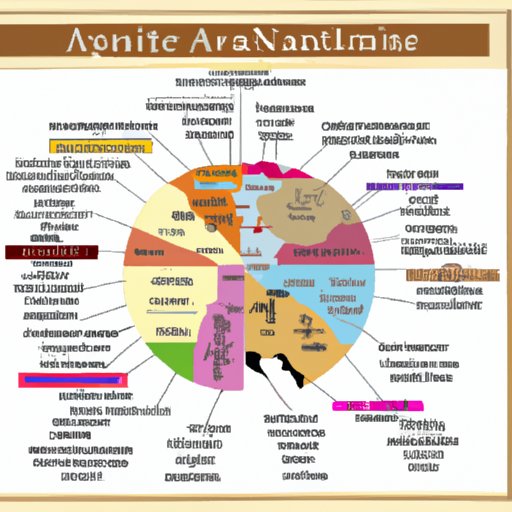Introduction
The population of Native Americans in the United States is a diverse and unique group that has been in the Americas for thousands of years. According to the 2020 Census, there are 6.8 million Native Americans living in the United States. This article aims to provide a comprehensive guide to Native American populations across the United States.

A Comprehensive Guide to Native American Populations Across the United States
Overview of Native American Populations by State
Native American populations vary by state, with some states having a higher percentage of Native Americans than others. Alaska has the highest percentage of Native Americans, with over 15% of the state being made up of Native American communities. Other states, like Oklahoma, New Mexico, and South Dakota, also have a significant percentage of Native American populations.
Percentage of Native Americans in Each State
According to the U.S. Census Bureau, the percentage of Native Americans per state varies from as low as 0.2% in West Virginia to as high as 15.2% in Alaska. Here is a breakdown of the top 5 states with the largest Native American populations:
- California: 723,000 (1.8%)
- Oklahoma: 398,000 (10.2%)
- Arizona: 325,000 (4.5%)
- Texas: 256,000 (0.9%)
- New Mexico: 219,000 (10.4%)
Historical Trends in Native American Populations
Native American populations have had a turbulent history, with their populations declining due to various factors, including disease, forced relocation, and government policies. According to historical data, Native American populations saw a significant decline from 5.2 million in 1800 to 250,000 in 1890.
Comparison of Different Regions in the United States
The populations of Native American communities in different regions of the United States vary in size and culture. Regions like the Southwest and Great Plains have significant Native American populations with distinctive cultural traditions. In contrast, regions like the Northeast and Northwest have smaller Native American populations with unique cultures and traditions.
Historical Perspectives on Native American Populations
Overview of Native American Populations in Different Eras
Native American populations have been present in the Americas for over 10,000 years, with over 500 different tribes living across the United States. The period of colonization by European settlers brought significant changes to Native American populations, with the introduction of new diseases, forced relocation, and treaty violations that impacted their communities.
Comparison of Population Trends in Different Time Periods
The population trends of Native American communities have changed over the centuries. Before the arrival of European settlers, Native American populations thrived, with an estimated 20 million people living across the Americas. However, the introduction of new diseases and forced relocation led to a significant decline in population. The 20th century saw a gradual increase in Native American populations, with the largest growth occurring after 1970.
Impact of Colonization and Government Policies on Native American Populations
The establishment of colonies and the United States government’s policies have had a lasting impact on Native American populations. Forced relocation, treaty violations, and the establishment of boarding schools aimed at assimilating Native American children into Western culture resulted in significant harm to their communities and cultures.
Efforts to Revitalize Native American Communities
Efforts to revitalize Native American communities include language and cultural preservation, tribal sovereignty, and land rights. The Native American Rights Fund, established in 1970, has been instrumental in advocating for Native American communities’ rights.
Exploring the Unique Cultures of the Native American Communities
Overview of Native American Cultures and Traditions
Native American cultures and traditions are diverse and unique, with over 500 different tribes living across the United States. Each tribe has its distinct cultural practices, languages, and beliefs. However, some general cultural practices are common across different tribes, such as powwows, storytelling, and the use of traditional medicine.
Comparison of Different Native American Cultures
The United States’ Native American populations comprise over 500 different tribes, each with its distinctive cultural practices. The culture of Native American communities varies according to their historical context and geographical location.
Importance of Preserving Native American Cultures
Preserving the unique cultures and traditions of Native American communities is essential to their identity and promotes cultural diversity in the United States. Additionally, preserving Native American cultures enables future generations to connect with their heritage and pass down their traditions and practices.
Efforts to Preserve Native American Cultures and Traditions
Efforts to preserve Native American cultures and traditions include language revitalization programs, cultural tourism, and the creation of historical archives. Tribes also work together to preserve cultural practices, with events like powwows serving as a way to promote and preserve Native American cultures.
Highlighting Native American Communities That Face Extinction
Overview of Smaller Native American Communities
Smaller Native American communities are those that have a population of fewer than 1,000 people and are at risk of extinction due to various factors like economic isolation, a lack of access to basic resources, and federal policies.
Extinction Risk Factors
Smaller Native American communities are at risk of extinction due to many factors, including poverty, inadequate healthcare, language loss, and a lack of access to resources like clean water and education.
Efforts to Preserve At-Risk Native American Communities
Preserving at-risk Native American communities requires addressing the factors that contribute to their extinction. This is done through economic revitalization programs, healthcare access, language revitalization programs, and the promotion of cultural tourism.
Importance of Preserving At-Risk Native American Communities
Preserving at-risk Native American communities is a critical part of promoting cultural diversity and fostering a sense of community among Native Americans. Additionally, these communities have unique knowledge and practices that can contribute to a greater understanding of the natural world and promote environmental sustainability.
The Impact of Modern Society on Native American Populations
Overview of Modern Societal Trends and Their Impact on Native American Communities
Modern societal trends have had a significant impact on Native American communities, including urbanization, globalization, and the influence of Western culture.
Comparison of Traditional and Modern Native American Lifestyles
Many Native American communities today face the challenge of balancing their traditional lifestyles with modern-day realities. This is evident in their efforts to retain their language and cultural practices while also adapting to Western and global trends.
Issues Faced by Native American Communities
Native American communities face many challenges, including poverty, inadequate healthcare, and environmental concerns like climate change and the loss of natural resources.
Efforts to Address Modern Society’s Impact on Native American Populations
Addressing modern society’s impact on Native American populations involves ensuring that they have access to modern-day resources while also preserving their cultural traditions. This is done through economic revitalization programs, healthcare access, and teaching Native American youth their cultural practices and language.
The Future of Native American Populations
Overview of Current Issues Affecting Native American Populations
The future of Native American populations is impacted by ongoing issues such as poverty, access to healthcare, and environmental sustainability. Additionally, the ongoing impact of colonization and government policies continues to present significant challenges for Native American communities.
Potential Future Scenarios for Native American Communities
There are several potential future scenarios for Native American communities, including a decline in population due to ongoing issues or a revitalization and preservation of their cultural traditions and languages.
Efforts to Address Future Challenges and Opportunities
Efforts to address future challenges and opportunities for Native American communities involve advocating for their rights and promoting economic, cultural, and environmental sustainability.
Conclusion and Call to Action
In conclusion, the state of Native American populations in the United States is diverse and complex. There is a need for ongoing advocacy and support to preserve their cultures and traditions while also addressing ongoing challenges like poverty, healthcare access, and environmental sustainability.
Conclusion
This article provided a comprehensive guide to Native American populations in the United States. From their populations across the states, historical trends and perspectives, unique cultures and traditions, challenges faced, and future opportunities, this article provides a wealth of information about the state of Native American communities today.
It is essential to preserve Native American cultures and traditions, and this requires ongoing advocacy and support from both Native American communities and the wider public to promote and preserve their unique knowledge and practices.
Call to Action
Join the efforts to preserve Native American cultures and traditions by supporting advocates and being a respectful visitor or guest when visiting different tribes or lands.
